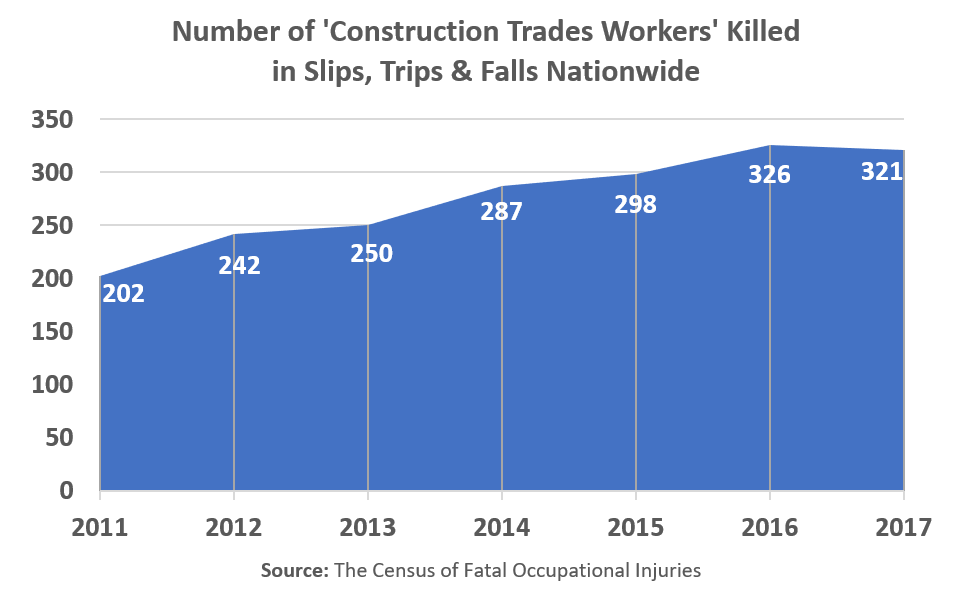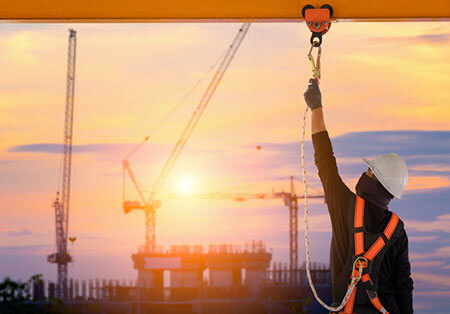Falls in the Construction Industry
Falls are the number one killer of construction workers. Since 2011, an average of 275 construction trades workers (laborers rather than supervisors or inspectors) have died in on-the-job falls. Sadly, that number is trending upwards, according to the most recent data from the Census of Fatal Occupational Injuries.
 .
.
Construction site falls can be caused by a variety of unsafe conditions, such as:
- Improperly guarded or constructed scaffolding
- Unprotected or unmarked ledges, wall openings, and floor holes
- Defective ladders
- Debris causing slip or trip and fall injuries
- Inclement weather when performing roof work
- Unguarded elevator shafts
- Unmarked trenches and excavation sites
Hazards that could potentially cause falling accidents on construction sites are unavoidable. Contractors, safety managers, and employers have no excuse not to educate their workers in fall prevention safety training. Yet too often, workers are not given the knowledge or equipment they need to do their jobs safely and end up paying the price for somebody else’s negligence.
If you or a loved one were injured in a construction site fall, you may be able to recover compensation for your injuries. Call 212-736-5300 to receive a free, no-obligation case review, so that we can fight for your rights and you can focus on a complete and speedy recovery from the physical and emotional injuries you suffered.
The personal injury attorneys of Block O’Toole & Murphy have won nearly 100 construction accident lawsuits exceeding $1,000,000 each. Receive a free legal consultation today by filling out our contact form or calling 212-736-5300.
Falls to a Lower Level
Fall prevention training is widely and freely available in resources such as the Occupational Safety and Health Administration’s (OSHA) Fall Prevention Training Guide. The guide focuses on three topics which make up a majority of lower-level falls: scaffolding safety, ladder safety and roofing work safety.
Because scaffolds need to be constructed before they can be used, they present unique dangers which workers need to be fully trained on. A scaffold also allows for the transportation of materials, which could add more weight than the scaffold is intended to hold. Other common scaffold hazards include:
- Lack of proper guardrails, midrails and toeboards on all open sides of the scaffold
- Scaffold collapse caused by improper construction or exceeded load capacity
- Active electrical lines which could be contacted by other building materials or equipment
Ladders present another falling hazard which workers may underestimate due to how common they are. Managers need to instruct their employees not to trust their weight to a ladder before they have inspected it for defects. If one finds a defective ladder on the jobsite, it must be taken out of service until it can be repaired. Other OSHA ladder safety guidelines include:
- Ladders should be able to support at least four times the maximum intended load
- Never try to use a stepladder as a straight ladder; always follow the manufacturer’s instructions
- Do not lean when using a ladder; move it over instead if something is out of reach
Workers who spend a lot of time on roofs are especially vulnerable to falling accidents. In fact, the latest fatal work injury report from the Bureau of Labor Statistics (BLS) found that roofers suffered the fourth highest fatality rate of any civilian occupation. This makes some sense because a roof is naturally surrounded by four open sides. Just because a job has potential hazards, however, does not mean anyone should be injured or killed while performing the task. Workers should always be aware of these roofing hazards:
- Slick surfaces caused by rain, snow, paint or other slipping hazards
- Unguarded skylights or other roof openings that are not marked off with guardrails
- Inadequate, ill-fitting or defective Personal Fall Arrest Systems (PFAS)
Other potentially dangerous situations that could cause a fall to a lower level involve elevator shafts, trenches or excavation sites, cranes, or defective stairwells. When high elevations present an active danger to workers on construction sites, contractors, foremen, subcontractors and employers must educate their employees and give them the knowledge and tools they need to do their job safely.
Slip and Fall Accidents on Construction Sites
Even with no increased elevations involved, falling accidents can cause serious injuries to construction workers. In 2017, BLS recorded 24,160 cases of a construction worker missing time from work due to a fall, slip or trip. Of these cases, 12,370 were injured in a slip, trip or fall on the same level, versus a fall to a lower level.
Common hazards which could lead to a slip, trip and fall accident on a construction site include:
- Environmental factors such as rain, ice, snow or mud that could cause slipping
- Debris such as tools, building materials, power cords, excess sawdust, grease or paint
- Surface defects such as potholes, uneven sidewalks, temporary walkways, or ruts leftover from the wheels of heavy machinery
In New York, these types of hazards may represent a violation of New York Labor Law 241(6) or Industrial Code 23-1.7. Both of these statutes apply specifically to construction, excavation, and demolition work. Labor Law 241(6) broadly states that contractors, property owners and employers must “provide reasonable and adequate protection and safety” to workers on the jobsite.
Industrial Code 23-1.7, meanwhile, specifies that any walking surfaces must be cleared of any “foreign substance which may cause slippery footing” and any “accumulations of dirt and debris… which could cause tripping.” In New York, when hazardous working conditions cause somebody to be seriously injured in a slip, trip or accident, there are numerous codes and laws which offer them legal protection. This brings us to the most critical law that protects New York construction workers from injury: the Scaffold Law.
New York Labor Law 240(1), aka the Scaffold Law

Broadly speaking, the Scaffold Law protects workers from gravity-related hazards such as falls or falling object accidents. The scope of Labor Law 240(1) is wide-reaching, and the statute is frequently cited in lawsuits brought by injured construction workers.
The Scaffold Law guarantees the safety of workers involved in the “erection, demolition, repairing, altering, painting, cleaning or pointing of a building or structure” who need to make use of “scaffolding, hoists, stays, ladders, slings, hangers, block, pulleys, braces, irons, ropes, and other devices” in order to perform that work safely.
The Scaffold Law is generally known as a strict or absolute liability statute. This means if a contractor, employer or property owner is found to have violated the law by failing to provide adequate protection against gravity-related hazards, then they should be found guilty regardless of any fault or comparative negligence that the worker may be accused of.
A common defense to lawsuits alleging a violation of the Scaffold Law is to accuse the injured party of being the “sole proximate cause” of the accident. Generally, however, for such a defense to be successful, it will have to be proven that proper safety devices were available on site, but the worker deliberately chose not to make use of them.
The Scaffold Law is one of the most important legal defenses a New York construction worker has. It protects all workers equally, regardless of whether you are a non-union worker or an undocumented immigrant. You have the right to a safe work place, and if that right has been violated, compensation may be available to you in the form of a personal injury lawsuit.
Case Results in Construction Site Falls
If you have been injured in a construction site fall, you may be able to receive compensation for your injuries. The experienced construction accident attorneys at Block O’Toole & Murphy have routinely demonstrated their ability to win the highest possible results in construction accident lawsuits such as:
- $53,500,000 jury verdict for a worker who was paralyzed from the waist down after falling while working to install an AC unit to a multi-story building
- $25,000,000 settlement for a construction worker who fell 12 feet from a building after being struck by a load of concrete forms being hoisted by a crane
- $12,000,000 settlement for a subway worker who was severely injured in a falling accident on a Manhattan construction site
- $9,500,000 recovery for a union roofing professional whose fall through an unsecured skylight cover caused severe spinal fractures
- $7,400,000 settlement for a union worker who was injured in a roof fall, requiring lumbar fusion surgery
- $6,793,881 verdict for a contract worker who fell while working on a government renovation project in Brooklyn
- $6,400,000 settlement for an ironworker who suffered numerous bulging discs in a fall at a Bronx job site
- $6,250,000 settlement for a construction worker who suffered paralysis in all of his limbs (quadriplegia) after falling roughly nine feet while performing framing work
- $3,000,000 settlement for a 57-year-old laborer who fell eight feet from atop a large air conditioning unit and suffered serious leg and ankle fractures
Simply call 212-736-5300 to receive a free, no-obligation case review with one of our lawyers.
Proudly serving the five boroughs, Long Island, upstate New York, and New Jersey.

